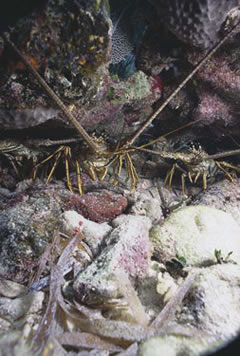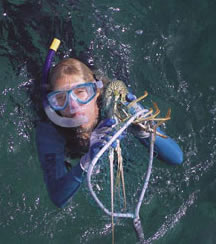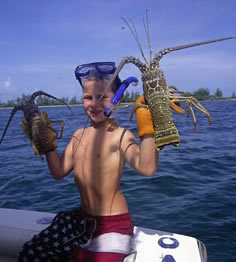Catching your fill of spiny lobster is one more good reason for a late-summer island run.

You'll find lobster on the reefs, but a surprising number come from grass ledges. |
“Now!” Kent yelled as he looked down from the tower of his center console. Almost instantly the boat was in neutral and simultaneous depth charges exploded off the transom as the pint-size divers, Adam and Sarah, jumped over. Adam was the first to resurface with a snorkel-wide grin and a big thumbs-up. Habitat found.
More conspicuous than needles in hay, but not so many that you just stumble on them, are the “habitats” Bahamian divers build for the purposes of attracting lobster. If you pay attention as you cross much of the Bahama banks you'll spot these lobster havens. Car hoods, corrugated roof panels and storm shutters seem to be the most common. Once in place, with a cinder block attached, they'll stay put for several years, unless you've had a hurricane or two. Miniature artificial reefs like this are seldom encountered in Florida waters, where it's against the law to deploy such structures, or even to take lobsters from ones you may find. In the neighboring Islands of the Bahamas, however, the habitats are part of the program. (Just don't plan on building your own over there.)
The Bahamas Ministry of Tourism stated that as long as the season is open, the lobsters you find on the bank are open to everyone. With that said, I'm sure the Bahamians would rather you didn't take lobster from the habitats, but we saw several locals diving in the area and they didn't seem to mind. It was clear they weren't having any problem getting their share of the lobsters.
The habitat we were on was a corrugated roof panel that Kent Hughes spotted while crossing Little Bahama Bank on his way to Walkers Cay the year before. The key to spotting these manmade lobster holes is having a calm day, high sun and if possible, added elevation from either standing on the gunnels or tower.

The key is finding low profile ledges. |
We were just north of Sandy Cay, which is roughly seven miles north of West End, Grand Bahama. After years of going to the Florida Keys to catch lobster, it was nice to take the 82-mile trip across the ocean versus the 188-mile drive on the highway. Some might wince at the thought of crossing the ocean in a center console, but given the option of trailering through Palm Beach, Broward and Dade counties, the ocean seemed calm in comparison.
With the clean, cool ocean water moving on to the bank the current was pretty strong. After Adam and Sarah successfully spotted lobster under the roof panel their job was to stay on top of it, while paddling on the surface, as we maneuvered the boat so we could anchor close to them in the 12 feet of water.
“There's lots of lobster,” Sarah Wickstrom yelled up as she swam hard to keep her position over the spot. It was time to gather tickle sticks, nets and a lobster bag. The sun was only an hour over the horizon and we were about to get our first lobster of the season.
The size of the average Bahamas lobster isn't much different than the Florida Keys lobster. For the most part, similar to the Keys, these lobsters are an annual catch. Not many survive to their third or fourth birthday that would enable them to grow to five pounds or more.
One of the big differences in lobstering in The Bahamas is that you can use pole spears or Hawaiian slings to catch them. The obvious problem with using a spear is that you can't release (alive) a short lobster or one with eggs. The spear also seems a little unsporting. There's no reason why you can't use a tickle stick and small landing net to get your limit of lobster.

Young diver Drew Hughes got his first Bahamian lobster just north of Sandy Cay in West End, Bahamas. |
Lobster season in The Bahamas opens August 1 and runs through March 31. The great thing about combining some lobster diving into your family fishing vacation is that when the temperature starts nearing triple digits in the cockpit, you have the option of diving into the clear, cool Bahamas waters.
From Bimini to where we were diving off West End you'll find ideal lobster grounds. Juan Comendeiro, of Miami, says lobster diving near and around Bimini can be fantastic. “The key is finding low-profile ledges a mile or so up on the bank. Look for current pushing through an area that has both turtlegrass, sea fans and some rocky ledges. That's where you'll find the lobster,” he said. He also said that the deeper ledges in 30 to 40 feet hold good numbers of lobster. But you have to remember that you can't take lobster while using scuba gear. Bahamas authorities are very serious about enforcing this and other fisheries rules—to the extent that law-breakers could forfeit their entire boat, much less their catch. Possession of lobsters and scuba gear on the same boat would be construed as a violation, regardless of how you caught the lobsters, according to the Ministry of Tourism.
Some other key areas to look for lobster are the finger channels that act as funnels separating the ocean from the bank. Just be sure to time your dive to coincide with slack tide. In these channels you'll find both rocky cuts and channels where the water has undercut the grassbeds, making ideal ledges for the lobster. The best way to locate which ledge to check is to watch your bottom machine as you go over the ledge, looking for at least two feet of relief between the grass and sand.
“There isn't any more,” Drew Hughes burbled as he popped his snorkel out of his mouth. What a great way to start the morning. Nine keeper lobster in the boat, and the day was just beginning.
FS
Bahamas Lobster Regs
Season: August 1-March 31
Bag limit: 6 per person (You may never have more than this limit on your boat, regardless of how many days you're in The Bahamas.)
Size: 3 3/8 inches carapace length or six inches tail length. (Be careful—the U.S. carapace minimum is 3 inches, so pay attention on how you measure your lobster.)
No scuba gear can be used while taking lobster.
Spearing legal lobster is legal in The Bahamas; pole spear or Hawaiian sling only. No spearing: within 1 mile of shore, New Providence and south side of Freeport, Grand Bahama; within 200 yards of coast of Out Islands.
Advertisement
Boaters must possess a valid Bahamas cruising permit, obtained at a designated Port of Entry.
For more information, call (800) 32-SPORT.
Egg-bearing lobsters are protected.
Any lobsters harvested in The Bahamas during their open season cannot be transported by private vessel into state waters during Florida's closed season.
Advertisement
Lobsters brought back to Florida must be in whole condition (not tailed).

